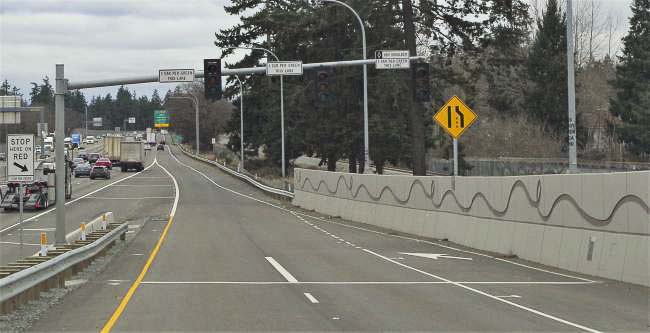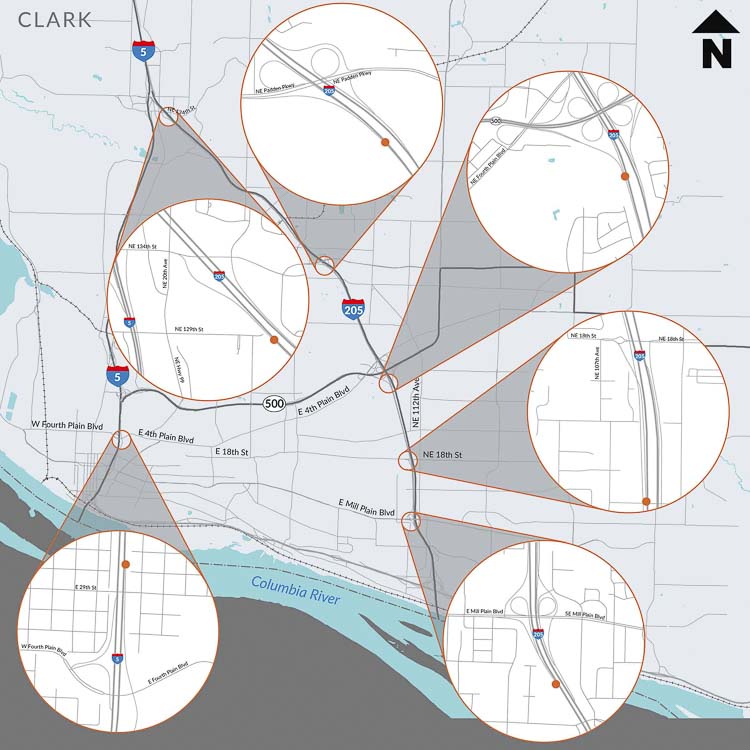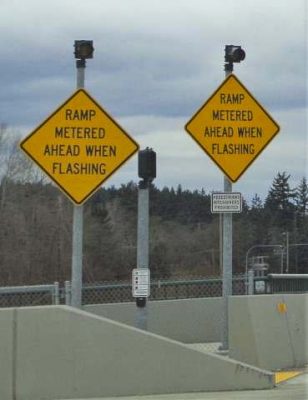
Ramp meters activating along southbound I-205 and northbound I-5 at Fourth Plain Boulevard to ease congestion
VANCOUVER – Interstate 205 and I-5 travelers in southwest Washington will now experience improved travel times and reduced congestion during their commute.
Washington State Department of Transportation’s contractor, Northeast Electric, LLC., installed new ramp meters at multiple I-205 and I-5 on-ramps in Clark County. The ramp meters will be activated individually beginning Tuesday, Aug. 13, and continuing throughout the remainder of the month.

Northbound I-5 ramp meter location
- Fourth Plain Boulevard on-ramp
Southbound I-205 ramp meter locations
- Northeast 134th Street on-ramp
- Northeast Padden Parkway on-ramps
- Northeast Fourth Plain Boulevard and State Route 500 on-ramps
- Northeast 18th Street on-ramp
- East Mill Plain Boulevard on-ramps
“We’re excited to turn on these meters and watch traffic flow more efficiently,” said Project Engineer Mike Briggs. “The new meters will help shorten everyone’s commute time, especially for those traveling between Vancouver and Portland.”

How ramp meters work
Ramp meters are traffic signals that operate according to real-time conditions on the highways and ramps. The traffic signals provide consistent gaps in on-ramp traffic, preventing multiple vehicles from entering the highway at the same time. More efficient merging allows drivers to continue traveling smoothly and keeps traffic flowing at highway speeds. Ramp meters also reduce the potential for collisions by 30%.
How to use ramp meters
Drive the vehicle up to the white stop line to trigger the ramp meter. If the light is red, stop at the white line. When the light turns green, accelerate and merge onto the highway. Most ramp meters allow only one vehicle to proceed with each green light, creating a 4- to 15-second delay between cars entering the highway.
Ramp meter data
According to the Southwest Regional Transportation Council’s 2022 Congestion Management Process Summary Report, the peak travel time on southbound I-5 from Main Street, milepost 3, to Jantzen Beach in Oregon was reduced by 11 minutes, following the activation of ramp meters.
On-ramp delays
While ramp metering benefits drivers already on the highway, it can produce delays for drivers merging onto the highway. Unlike other states, ramp meters in Washington are not set to run during a scheduled time of day. Rather, WSDOT ramp meters adapt and operate based on real-time traffic conditions on the freeway. Additionally, WSDOT traffic crews will fine-tune ramp meter operations and closely monitor traffic at each ramp following activation.
WSDOT’s goal is to balance the needs of drivers merging onto the highway with the needs of drivers already there.
Also read:
- Expect delays on northbound I-5 near Ridgefield through May 9Northbound I-5 travelers near Ridgefield should expect delays through May 9 as crews work on improvements at the Exit 14 off-ramp to support future development.
- 6-cent gas tax hike central to new transportation deal in WA LegislatureA proposed 6-cent gas tax hike is central to a transportation funding deal under negotiation in the Washington Legislature, aimed at raising $3.2 billion over six years.
- Letter: C-TRAN Board improper meeting conductCamas resident Rick Vermeers criticizes the C-TRAN Board for misusing parliamentary procedure during a controversial vote on light rail.
- Opinion: TriMet’s ‘fiscal cliff’ a caution for Clark County taxpayersRep. John Ley warns that Portland’s financially troubled TriMet transit system could pose major risks to Clark County taxpayers as the I-5 Bridge replacement moves forward.
- Travel Advisory: Expect daytime delays on northbound I-5 near Woodland for guardrail repairs, April 18WSDOT will close the left lane of northbound I-5 near Woodland on Friday, April 18, to repair guardrail and improve driver safety.









